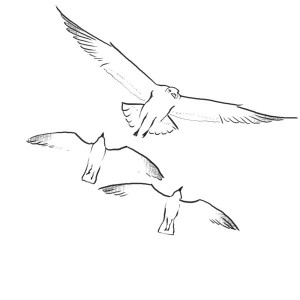
Continuing the series of pictures we couldn’t use in the book itself, here are some birdies.
Click on the images to see them larger and read more…


Continuing the series of pictures we couldn’t use in the book itself, here are some birdies.
Click on the images to see them larger and read more…
The fantastic website www.livefortheoutdoors.com has been a source of inspiration to us for many years. It is responsible for many of our wild camping exploits (although they are careful not to encourage it!) and is the encyclopaedic online presence for magazine titles ‘Trail’ and ‘Country Walking’. It was lovely to read this morning that they have posted a little review of Skimming Stones and Other Ways of Being in the Wild:
It somehow manages to say something about nature that the rest of us can’t. Yes, there is a practical side to it, but there’s also a philosophical message that comes through as well. A great book for anyone who loves nature and wants to get more in touch with the great outdoors.
March is a phoenomenal time to wander outside into any of the rural spaces that exist around us and I urge everyone to take advantage of the brighter mornings and longer evenings. You don’t need to plan trips to our stunning fells or sweeping coastline; in parks and gardens and any rough scrap of land with vegetation and trees, we find nature stretching its limbs after the long sleep of winter; the bursting forth of green leaves and fleshy, furry buds. Slow down. Stop, look and listen.
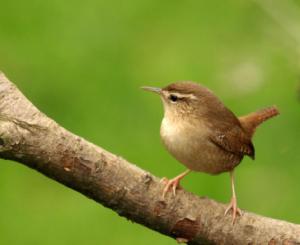 Birdsong becomes a powerful and peaceful morning wake-up call through our bedroom curtains even in towns and cities as winter migrants return from international tours and battle it our for territory. It’s nature’s X-Factor, only far more impressive and tuneful – the humble wren sings a song that contains 740 different notes per minute and which can be heard more than 500 metres away. All too often we take such things for granted, yet they are enchanting to stand and listen to. Learning to identify the differences between birds is rewarding work; birdsong has been proven to improve our mood and enhance cognitive abilities.
Birdsong becomes a powerful and peaceful morning wake-up call through our bedroom curtains even in towns and cities as winter migrants return from international tours and battle it our for territory. It’s nature’s X-Factor, only far more impressive and tuneful – the humble wren sings a song that contains 740 different notes per minute and which can be heard more than 500 metres away. All too often we take such things for granted, yet they are enchanting to stand and listen to. Learning to identify the differences between birds is rewarding work; birdsong has been proven to improve our mood and enhance cognitive abilities.
We should learn to value the fringes of our towns and cities where such wonders take place, the forgotten lanes and stands of trees, the scrappy rough ground behind the buildings, the places were urban and rural meet. These are hidden worlds filled with nature, playgrounds for young people and places to just be. But they are also the places at risk if the current planning legislation is passed. For my thoughts on the matter, you can read my guest blog for the National Trust. I believe we must protect and celebrate such spaces, improve our access to them and ensure that nature has a free hand to flourish. We should all live a little more for the outdoors.
– Rob –

Here is our seven-minute appearance on The Culture Show in all its glory, hope you like it!
We talk about Skimming Stones, and why it is that we need to reconnect with nature.
If you want more, do please grab a copy of the book, or if you’re in London on April 28th you can join us and Gavin Pretor-Pinney (author of The Cloudspotter’s Guide) on an urban wilderness retreat, courtesy of The School of Life.
– Leo –
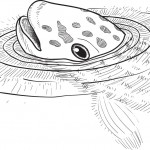
Rob and I are going to be running a class with The School of Life in April, working with the awesome Gavin Pretor-Pinney to help city folk like us learn to tune in and reconnect with nature.
From the School of Life’s website:
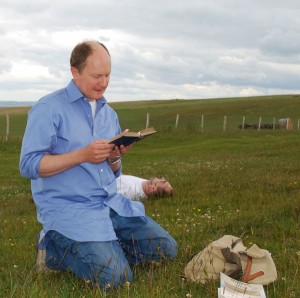 SATURDAY 28 APRIL 2012, 10.00-17:30
SATURDAY 28 APRIL 2012, 10.00-17:30
We believe that clouds are for dreamers and their contemplation benefits the soul. Indeed, all who consider the shapes they see within them will save on psychoanalysis bills.
– From the Manifesto of The Cloud Appreciation Society
Urban life can crowd us out. The pressure of work, the hectic streets, the cramped commute. We dream of getting away. But do we really need to leave the city to escape it?
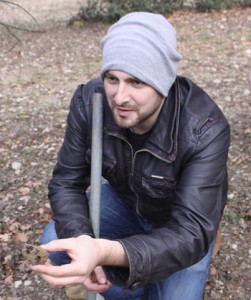 Join three of the UK’s most exciting nature writers for an adventure in the heart of the city. Gavin Pretor-Pinney will show us how to appreciate the great urban wilderness of the sky and capture it on paper. Rob Cowen and Leo Critchley will teach us how to track animals and forage wild fruit.
Join three of the UK’s most exciting nature writers for an adventure in the heart of the city. Gavin Pretor-Pinney will show us how to appreciate the great urban wilderness of the sky and capture it on paper. Rob Cowen and Leo Critchley will teach us how to track animals and forage wild fruit.
Within earshot of sirens and sight of tower blocks, we’ll throw off our city blinkers and become absorbed in the worlds of other creatures. We’ll learn about the science and philosophy of tuning into bird song and sensing the onset of rain. In the process, we’ll discover how we can escape the clamouring city any time we like.
Gavin Pretor-Pinney is a well-loved TV documentary broadcaster and author of the bestselling books, The Cloudspotter’s Guide, The Cloud Collector’s Handbook and The Wavewatcher’s Companion. He is founder of The Cloud Appreciation Society and has just compiled Clouds That Look Like Things, a selection of photographs by the Society’s 28,000 members.
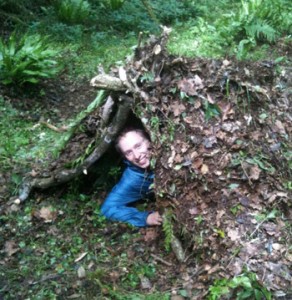 Rob Cowen and Leo Critchley have just published their first book, Skimming Stones and other ways of being in the wild, a thoughtful adventure in learning simple skills that help us connect deeply with nature. They are both young Londoners who describe their project as being ‘born out of a wish to share the contemplative, reflective pleasures and joys that were well-known to our grandparents, but which are in danger of being lost and forgotten.’
Rob Cowen and Leo Critchley have just published their first book, Skimming Stones and other ways of being in the wild, a thoughtful adventure in learning simple skills that help us connect deeply with nature. They are both young Londoners who describe their project as being ‘born out of a wish to share the contemplative, reflective pleasures and joys that were well-known to our grandparents, but which are in danger of being lost and forgotten.’
– Leo –

Our monthly column in the Independent starts again today after a hiatus to allow us to finish writing the book, which came out on Thursday. Click the link below to read the feature and learn a bit about tracking wildlife around you. What animals frequent your street, garden or nearest wood and fields?
I understand it’s easy to track the Hollywood star, Will Smith. You just scan the area and look for Fresh Prince…
Yesterday, I had a very pleasant chat with Sean Moncrieff on NewsTalk Ireland.
We talked in particular about the transformative effect that spending quality time in nature can have.
As you become an adult, there’s a lot of other pressures, and these things fall by the wayside… there are parallels with meditation; little rituals that help you become mindful and bring yourself back into the moment…
There’s so much in favour of spending time reflecting on and experiencing nature. We all know this instinctively, we prefer a room with a view or a house with a garden, and yet many of us rarely take advantage of the abundant (and potentially free!) resources out there.
Listen to Leo on NewsTalk Ireland
– Leo –

Rob spoke to Hannah Murray at Talk Radio Europe: Spain a couple of days ago.
Nowadays, less than a quarter of children visit a local patch of green weekly. What sort of damage could this do in the long run?
The human animal evolved to live in nature, and it has a very powerful effect on us when we spend time in nature – when we slow down and spend time in it.
Are we so worried about the risks of letting children roam, that we are exposing them to the larger risks of becoming disconnected from the world around them, of becoming too used to fast-cut media and 2D screens?
Listen to Rob on Talk Radio Europe
– Leo –

This week involved a trip so brief, bizarre and beautiful it seemed almost dreamlike. I was asked to write a feature for Crufts Magazine that required I spent 24 hours in deepest, darkest Scotland in the company of a couple of dog sled racers and their thirty Siberian huskies.
The journey north was fairly arduous and involved an evening train ride to Edinburgh before I hired a car and navigated the hour and a half through driving snow to a remote area of Perthshire. The final miles were in complete darkness with just the snowfall and black sky. As the Scots pine closed in around the single track road, Highland cattle wandered across casually out of the trees, their caramel, shaggy coats with a fresh crust of white.
 The accommodation was basic (a cabin) and cold, but the welcome from owners John and Mary warm and whisky fuelled. At dawn we were up to see a copper and duck-egg blue sunrise glowing over the white landscape and dark tree tops.
The accommodation was basic (a cabin) and cold, but the welcome from owners John and Mary warm and whisky fuelled. At dawn we were up to see a copper and duck-egg blue sunrise glowing over the white landscape and dark tree tops.
The husky racing was thrilling to behold and I have never seen animals happier; it is as if running with a sled somehow scratches an itch that would otherwise drive huskies mad. After an hour or two watching these furry athletes accelerating into the trees, my gaze was drawn to the snow beside the trails. Near the dogs’ unmistakable prints, I noticed other tracks. Rabbits had been lolling through the snow and, close by, another dog-like animal had taken a keen interest.
 Joined by John and Mary’s toddlers, I followed the fox tracks up and into the thick Scots pine. A carpet of pine needles was disrupted in places by roe deer tracks and we started to see the mini motorways used by the animals that call the woods home. Footprints, chewed stems, pine cones nibbled by the red squirrels; the joy of animal tracking is piecing together the stories that unfold in such places. By taking the time to walk away from the usual trails, slow down and read the ground around us, we enter into a new way of looking and relating to the landscape.
Joined by John and Mary’s toddlers, I followed the fox tracks up and into the thick Scots pine. A carpet of pine needles was disrupted in places by roe deer tracks and we started to see the mini motorways used by the animals that call the woods home. Footprints, chewed stems, pine cones nibbled by the red squirrels; the joy of animal tracking is piecing together the stories that unfold in such places. By taking the time to walk away from the usual trails, slow down and read the ground around us, we enter into a new way of looking and relating to the landscape.
Once they had learnt what each was, it was lovely to see the kids picking out the prints for ‘Mr. Fox’. In our chapter on animal tracking in the book, we discuss how tracking elicits a physiological as well as psychological change, one that brings us closer to every landscape. We connect on another level, down amongst the leaves. Perhaps at the heart of this ancient art is this sense of ‘becoming’ with the landscape and its inhabitants. Their natural inquisitiveness sparked off a wonderful creativity. They told me about their favourite ‘rooms’ in the woods and where they met ‘the leprechauns’ for dinner. I asked what other creatures they’d met in the woods and their answer stopped me in my tracks: ‘big cats’.
I studied the snow and mud even more intently as we drifted back to the husky trails. A noise from the hill behind and John came whizzing past with a dog team of six, the huskies bounding en masse in perfect synchronicity, ears pinned back, tongues wagging. Later, over tea, John and I talked about his children’s wonderful playground and I related the beauty of their imaginary worlds, mentioning the stories of big cats. “Ah.” said John. “That bit wasn’t a story.”
– Rob –
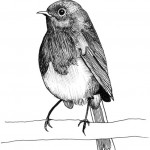
There was a beautiful and revealing interview with David Hockney on Radio 4 over Christmas, which I have only just had the chance to listen to. It was in honour of his forthcoming exhibition A Bigger Picture, the vivid reflections of the East Yorkshire landscape he grew up amongst and has spent the last two years absorbed in. He even relocated from California to Bridlington to complete the project.
As Andrew Marr and Hockney walked the muddy tracks through the trees they discussed the powerful influence of the land over the artist. Most interestingly, the way Hockney felt an intense connection to nature that developed during the project. He has been returning to paint, photograph and sketch the same spot with an obsessive regularity, out in all weathers to try to capture the essence of the place by being present in the myriad variants of weather and light that happen at different times of the day and the season.
Hockney’s ‘excuse’ for being out in nature is the paintbrush, but it could have been anything – carving an elder whistle, making a fishing float from a feather, tracking the prints of animals. The point is that his activity rooted him utterly into the place. This is also a defining principle of our book, Skimming Stones and Other Ways of Being in the Wild; it is physically and mentally rewarding to look deeply into nature. It’s not just how many peaks we cover, but how well we cover them. Time spent returning to the same a hill, fishing the same bank of a river or revisiting a wood to sleep in DIY debris den familiarises us so completely with that patch of earth that we can’t fail to feel linked to the greater rhythms of nature and feel a sense of belonging.
As Hockney notes in the interview, “In April for six weeks the landscape changes daily.” He became attuned to the variants and noted how even the same metre of earth can change radically from dawn to dusk. Hockney even started to relearn the names of plants like the wild carrot or ‘Queen Anne’s Lace’ so he knew what he was painting. This prompted in him a deeper way of looking, a sense of scale and understanding of how the miniature landscape constitutes the whole.
In the final chapter (on wild walking) in our book, we set up a tent on the summit of Haystacks after many hours of fell climbing. All day we had been taking in grand vistas and sweeping views of the Lakeland hills, but had also been using natural navigation techniques to determine our bearing: reading the rings on tree stumps, employing the tree-tick principle as a rudimentary compass. This had forced us to look more closely at every aspect of the fells and as we sat with our legs aching in this lofty perch we naturally took in the details all around us.
A few metres before us lay a small stretch of water that mirrored the same colours of the setting sun as Buttermere hundreds of feet below. The heather, twisted and green seemed like a Bonsai forest and the meadow pipits that picked about it, giant winged dinosaurs. We both watched the scene unfurling above the clouds in quiet absorption, the sky framing the stage with changing backdrops of golden, duck-egg blue and pink washes. It was a living landscape painting played out on nature’s ever-changing canvas.
– Rob –

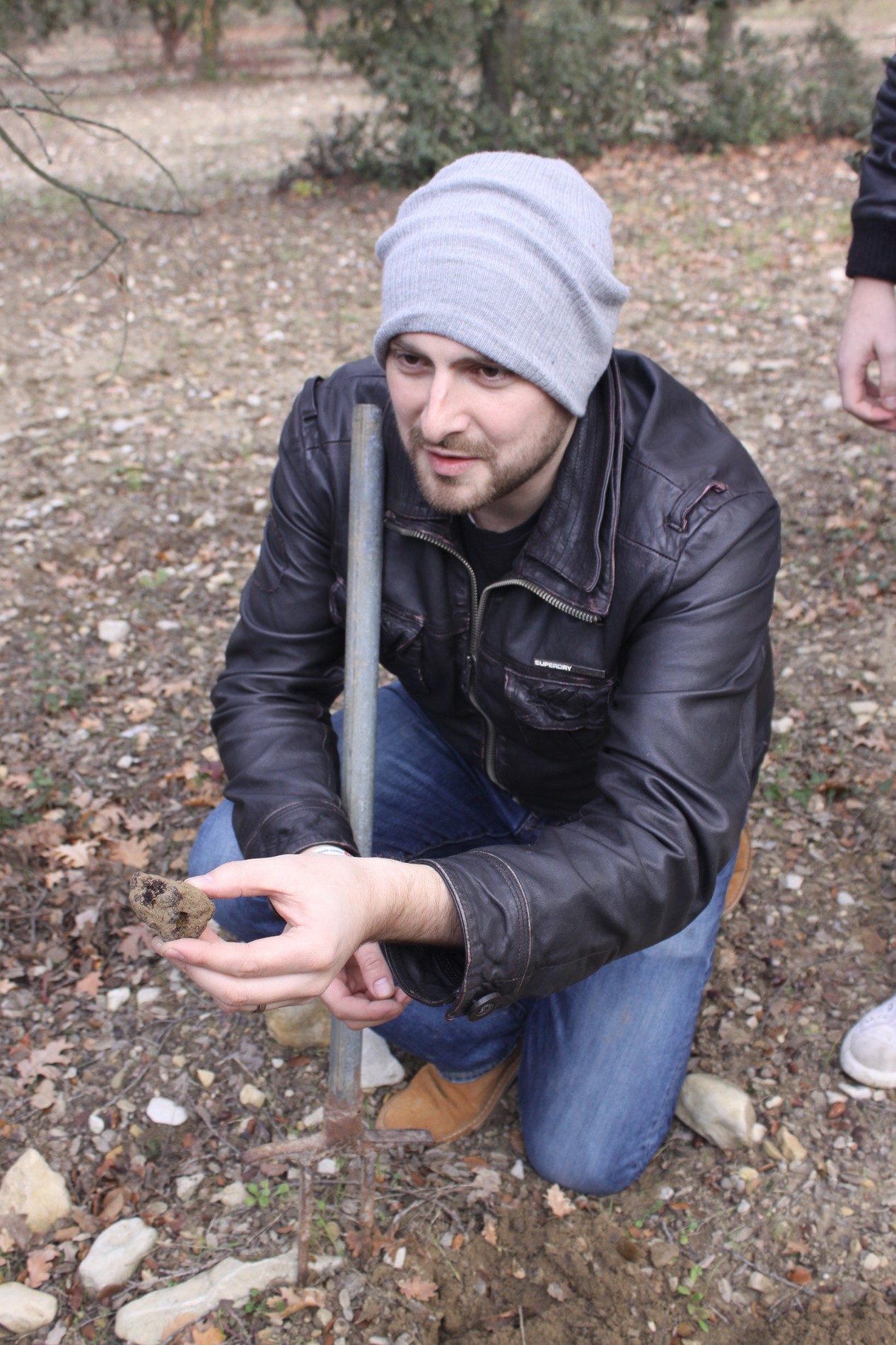 Having picked and eaten wild mushrooms and fungi of various kinds in the UK, there has always been one that has intrigued me by its rarity and reputation: the truffle. It’s a mysterious fungus and one I have never really eaten aside from the usual infusions in oil or salami that crop up in delis. The Italians describe its legendarily permeating odour as ‘gas’ and it certainly has a whiff of a faulty cooker, yet people seem to become obsessive devotees to its unique flavour. Certain areas of France go so crazy for the ‘black diamond’ they even hold a Mass in its honour, swapping the ‘corpus Christi’ wafer for a slice of the stuff.
Having picked and eaten wild mushrooms and fungi of various kinds in the UK, there has always been one that has intrigued me by its rarity and reputation: the truffle. It’s a mysterious fungus and one I have never really eaten aside from the usual infusions in oil or salami that crop up in delis. The Italians describe its legendarily permeating odour as ‘gas’ and it certainly has a whiff of a faulty cooker, yet people seem to become obsessive devotees to its unique flavour. Certain areas of France go so crazy for the ‘black diamond’ they even hold a Mass in its honour, swapping the ‘corpus Christi’ wafer for a slice of the stuff.
One of the joys of writing travel features is the potential for adventures to fall into your lap and I jumped at the offer from The Independent to make a trip down to Provence to find the region’s number one winter wonder.
My lovely B&B, ‘Les Ursulines’, was hunkered down amongst the vines a few miles outside Valreas. Passing through the subdued lavender avenues and vineyards now stripped of their fruit, it looked a different region to the lush green and purple place made famous in Peter Mayle’s book, A Year in Provence. If an interior designer were to describe the Vaucluse department in December they would probably give it a name like ‘beautiful/industrial’, for every inch of earthy field is apportioned to profit. Winter is the land’s grand exhale after the harvesting storm. The ground looked exhausted and vines sat exposed, their spines twisted in neat rows, only occasionally fringed with the odd russet, brown and red leaf blowing in the surprisingly warm air.
There was still wildness. Mountains dominated the horizon and Mt Ventoux lay like a pile of black grapes ready for pressing under the blue sky. Closer by were the sporadic stands of trees. To the untrained eye these may seem unusual amongst the vines, a waste of space for a place where every square foot is cultivated for a purpose. These aren’t the cypresses planted to provide windbreaks against the famous ‘Mistral’, but rather two types of oak – green and white – larders for the farmers’ winter harvest.
Jean-Pierre, the owner of the B&B, was to be my truffle guide. Unfortunately he spoke no English. Nor did his wife. Despite the best efforts of author Joanne Harris in her previous life as a French teacher, my GCSE-level French is woefully inadequate when trying to pick up the intricacies of the fruiting process of Tuber melanosporum. This added an air of excitement and confusion, but also proved the point that much in conversation is body language.
Jean-Pierre gestured to his car. I got in. Within a minute we were tearing up dust on a little road through the vines and pulling up at an old farmhouse. Men huddled together through the arch smoking and eyeing us suspiciously. Handshakes were exchanged and one  begrudgingly went inside. After a moment, he returned with bespectacled man in a beat-up army jacket and a dog on a length of rope. This was Jacques and Diane, neither of who spoke any English either.
begrudgingly went inside. After a moment, he returned with bespectacled man in a beat-up army jacket and a dog on a length of rope. This was Jacques and Diane, neither of who spoke any English either.
I followed Jacques to his lines of oak. The earth was soft, perfect for prints, and as he guided his faithful hound through the trees, my eyes were drawn down for a spot of impromptu animal tracking. Diane’s prints were everywhere but in patches close to denser vegetation, other pig-like impressions littered the ground. I had my suspicions. ‘Sanglier,’ Jean-Pierre confirmed before making the sign for a rifle, ‘bang bang, very nice.’
Soon Diane was earning her keep, scrabbling a few layers of ground away before Jacques called her away. I bent down beside him and was hit by the pungent smell. The very soil was impregnated with it. I helped Jacques ‘clod’ the ground and then break it up  by hand until I saw it; black, bobbly and about the size of an egg.
by hand until I saw it; black, bobbly and about the size of an egg.
The reverence in which the black truffle is held was clear. We stood in silence, possibly due to our lack of a common language, but mostly because of the power of this delicacy. The hunt continued until we had filled a small sackcloth bag.
On the market a black truffle of the sizes we were uncovering may be worth up to £40 each. Sometimes more. There is no question of their value and part of their mystery is that there is no exact science to their cultivation. Impregnated oaks may take ten years to start ‘truffling’ and even then, there is no guarantee. I began to see why people are so insular about them in this area; they are a tax free high-value commodity found in the ground that can make a man rich over a season.
We returned under to the B&B under a purpling sky. In my pocket was a gift from Jacques, a perfect specimen that, even when wrapped in two layers of foil and inside a sealed jam jar in a fridge, still stank out the room. Best served simply, we cooked paper-thin slices of truffle with scrambled egg and served it with wilted chard. The taste was incomparable. Nothing else has the same flavour, a pleasant savoury ‘umami’ as the Japanese class it.
As I returned to England my eyes scanned the fields and forests around the train tracks wondering if any held white truffles, the British edible truffle. To hunt these, it is best to look for areas of disturbed earth, bumps in the forest floor or any line of ants disappearing into a mound. I knew I’d never scan a woodland floor without imagining these subterranean hidden treasures. My clothes still smelt of the fungus and I could close my eyes and imagine its taste; I had become acclimatized.
– Rob –